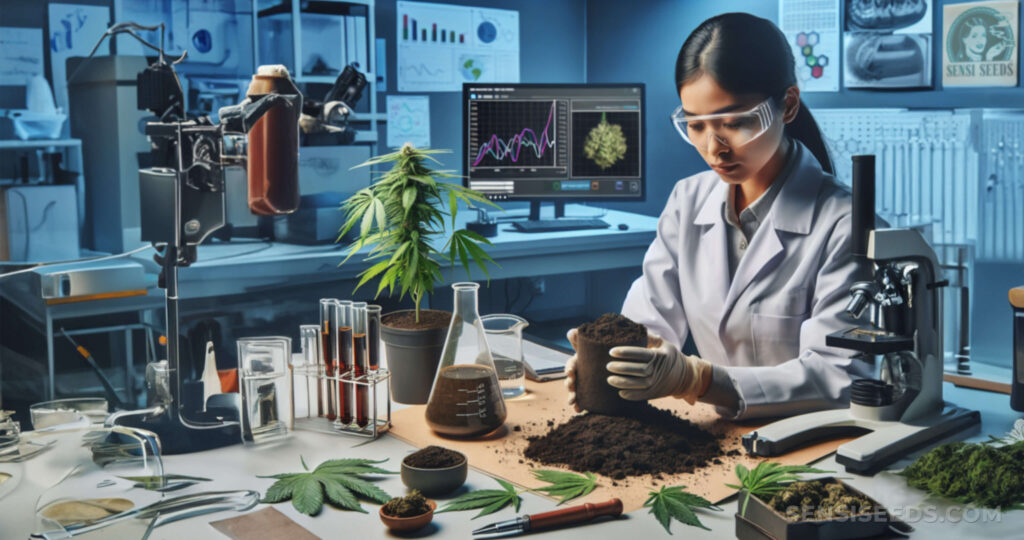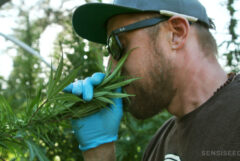Soil is the lifeblood of all plants, including cannabis. But how do you know what soil is best for your weed plants? What qualities should you look for when creating your own cannabis soil mix, and is it possible to grow weed in store-bought potting soil? We answer all these questions and more below.
- Key points:
- Pros of store-bought soil for cannabis:
- Cons:
- Store-bought cannabis soil is ideal for:
- How to fertilise cannabis plants growing in store-bought soils:
- Pros of growing cannabis in living soil:
- Cons:
- Cannabis living soil is ideal for:
- How to make a light cannabis potting soil (ideal for using in combination with liquid fertilisers)
- How to make a “hot” cannabis super soil (no need for extra feeding)
- The best soil for autoflowers
Let’s talk dirty – literally. There are many aspects to growing cannabis, but soil health is easily among the most important. And while all dirt might look the same at a glance, picking out the right soil for your cannabis garden might not be as simple as you think.
In this article, we take a deep look at soil, what it is, and how the health of your soil directly impacts the health of your cannabis plants.
We’ll show you exactly what to look for in store-bought soils and how to pair them with fertilisers, as well as share living soil recipes that can keep your weed plants fed from seed to harvest.
Keep in mind that this article is focused on indoor growing. If you’re an outdoor grower, check out this article on the best soil for outdoor cannabis plants.
What are you waiting for? Let’s get our hands dirty!
Key points:
- In nature, soil provides plants with all the nutrients and water they need to grow.
- You can opt to grow cannabis in store-bought soil, though you’ll need to fertilise your plants after 2-4 weeks.
- Alternatively, you can also make cannabis potting soil at home with a few simple ingredients.
- To avoid having to fertilise your plants at all, you can grow them in living or super soil.
Geology 101 – What is soil and why is it important for plants?
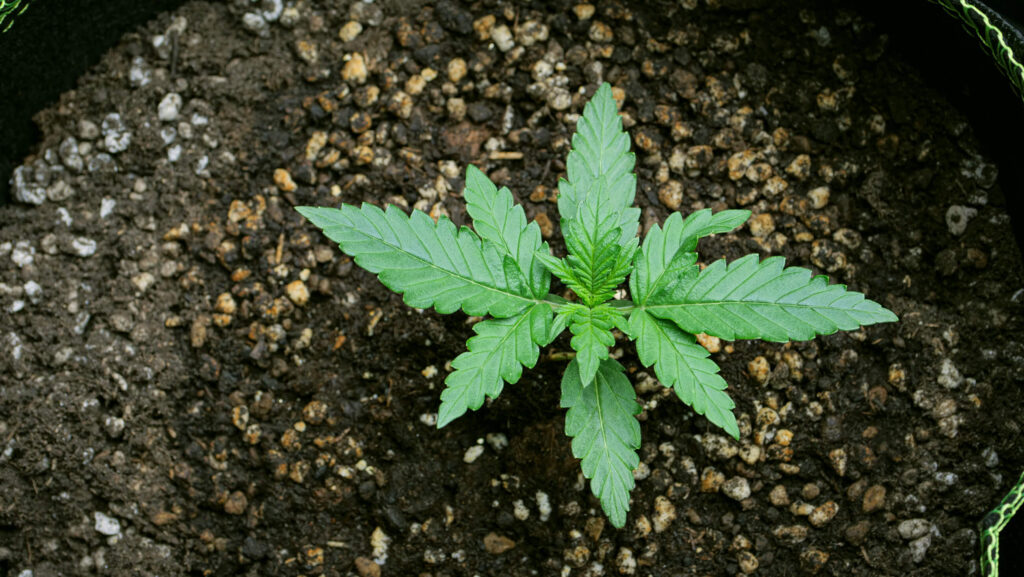
Soil is the lifeblood of plant life. In nature, soils form through the weathering of rocks and the decomposition of organic matter (such as plants and animals). As soils form over time, they develop layers that geologists refer to as horizons. As cannabis cultivators, when we talk about the soil we use to grow plants, we’re referring to Horizon A (ie topsoil) – the first layer of soil that’s rich in organic matter and houses most plant roots, insects, and microorganisms.
Soil is important to plants for 2 main reasons. First and foremost, it houses the roots of plants and keeps them secured in place. More importantly, however, soil contains the nutrients and water plants need to live.
Most of these nutrients and water come from humus, an organic component of soil made up of decomposed plant and animal matter. Insects help distribute humus, while microorganisms such as bacteria and fungi create it and also break down the nutrients it contains, making them accessible to plants.
What kind of nutrients should cannabis soil contain?
Cannabis, like all other plants, needs 3 core nutrients to survive; nitrogen (N), phosphorus (P), and potassium (K). These components are commonly referred to as macronutrients due to how central they are to plant life. In order to flourish, however, cannabis plants also benefit from the presence of micronutrients, particularly calcium (Ca), magnesium (mg), sulphur (S), boron (B), chloride (Cl), copper (Cu), iron (Fe), manganese (Mn), molybdenum (Mo), nickel (Ni) and zinc (Zn).
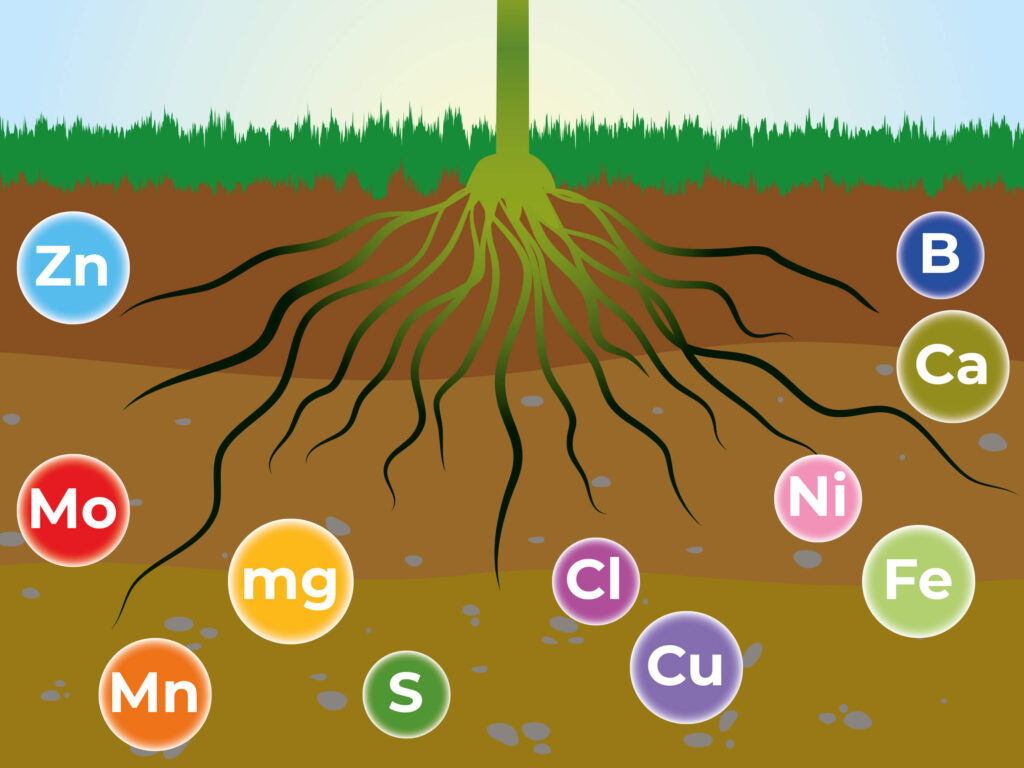
If you were to take a walk through a flourishing forest, take home a handful of its topsoil, and send it to a laboratory to be analysed, you’d likely find that it contains a rich balance of many of these nutrients.
In nature, therefore, cannabis naturally gets all the nutrients it needs from the ecosystem in which it grows. When growing cannabis at home, however, we need to provide these nutrients to our plants manually to ensure they stay healthy and consequently reward us with the best possible harvest of flowers. One of the best ways to do this is by growing our plants in high-quality soil.
What kind of soil can you use to grow cannabis?
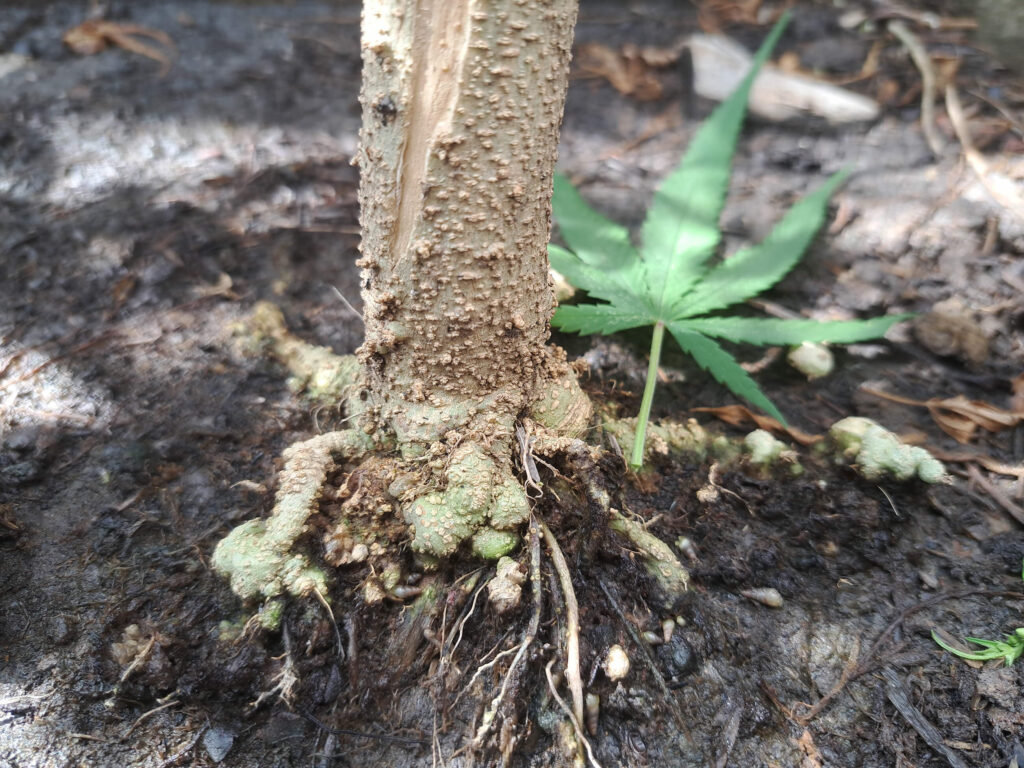
When growing cannabis at home, you can take one of two basic approaches when it comes to choosing soil for your plants:
- Most growers like to grow their plants in store-bought soil. These soils are super easy to source and typically contain some nutrients, but will need fertilisation to really produce the best harvest.
- Alternatively, some cultivators opt to take a more natural approach to cannabis cultivation by growing their plants in living soil/super soil. These soils are typically rich in organic matter and can keep plants fed for several weeks or even throughout their entire lifecycle.
What to look for in store-bought cannabis soil:
Cannabis grows best in light, airy soil that drains well. Hard and compacted soils, on the other hand, will make it difficult for your plants to develop healthy roots, resulting in slow and stunted growth. Moreover, these soils often don’t drain properly, increasing the risk of your plants developing root rot caused by fungi and bacteria that flourish in waterlogged soils.
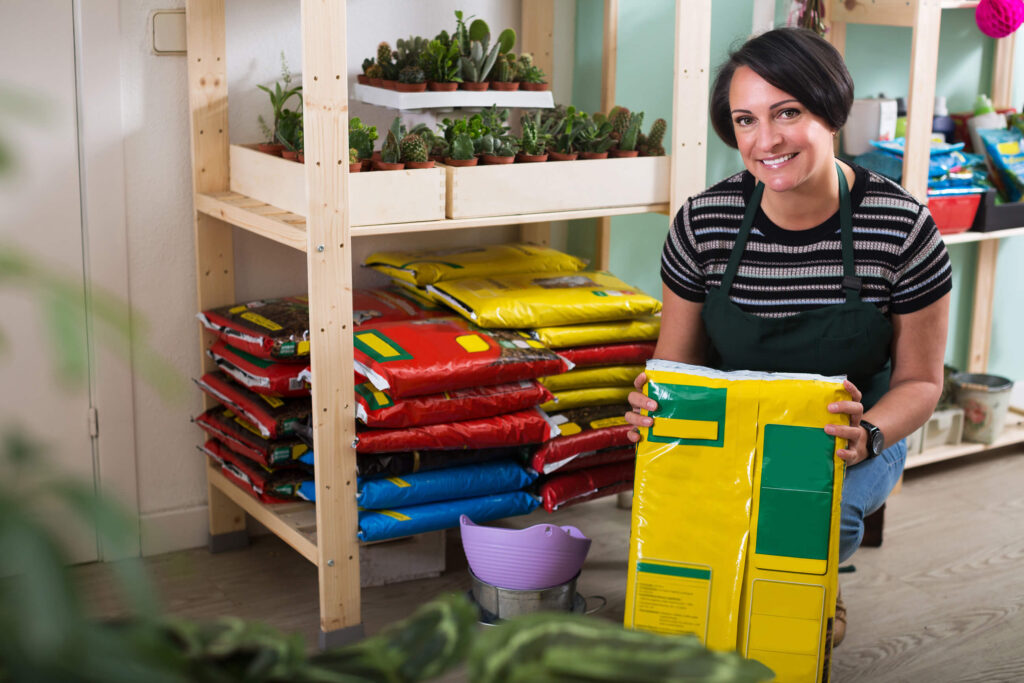
When buying soil for cannabis at a store, look for soils that:
- Have a dark colour similar to that of used coffee grounds.
- Are moist, but not wet.
- Smell like fresh dirt.
- Contain peat moss or coco, vermiculite, and perlite. These components help improve soil structure, aeration, drainage, and water retention. Note that peat moss is a non-renewable substance, which is why many environmentally conscious growers are using coco in their cannabis gardens instead.
- Contain a good balance of macro and micronutrients, particularly nitrogen, phosphorus, potassium, calcium, magnesium, and sulphur.
- Have a pH of 6.0-7.0. Most cannabis strains perform best in slightly acidic soils.
Be sure to ask your retailer about the nutrient content of your soil, and avoid any soils meant for ornamental plants or vegetables. These are typically too nutrient-rich for seedlings and young vegetative cannabis plants. Where possible, look for organic soils containing compost, humus, guano, and other organic matter – these soils will have a slow release of nutrients and can keep you from having to feed your plants for several weeks.
Some ready-made soils that work well for cannabis include:
- Fox Farm soils. This brand is well-respected in the cannabis industry and offers many different soil blends, including their Happy Frog mix (which is light in nutrients) and Ocean Forest blend (which is more nutrient-dense).
- Plagron soils. Plagron’s GrowMix blend is pre-fertilized, while Cocos Premium is a coco-based substrate and contains no nutrients (ideal for growers wanting to use liquid fertilisers).
Benefits of growing cannabis in store-bought soil
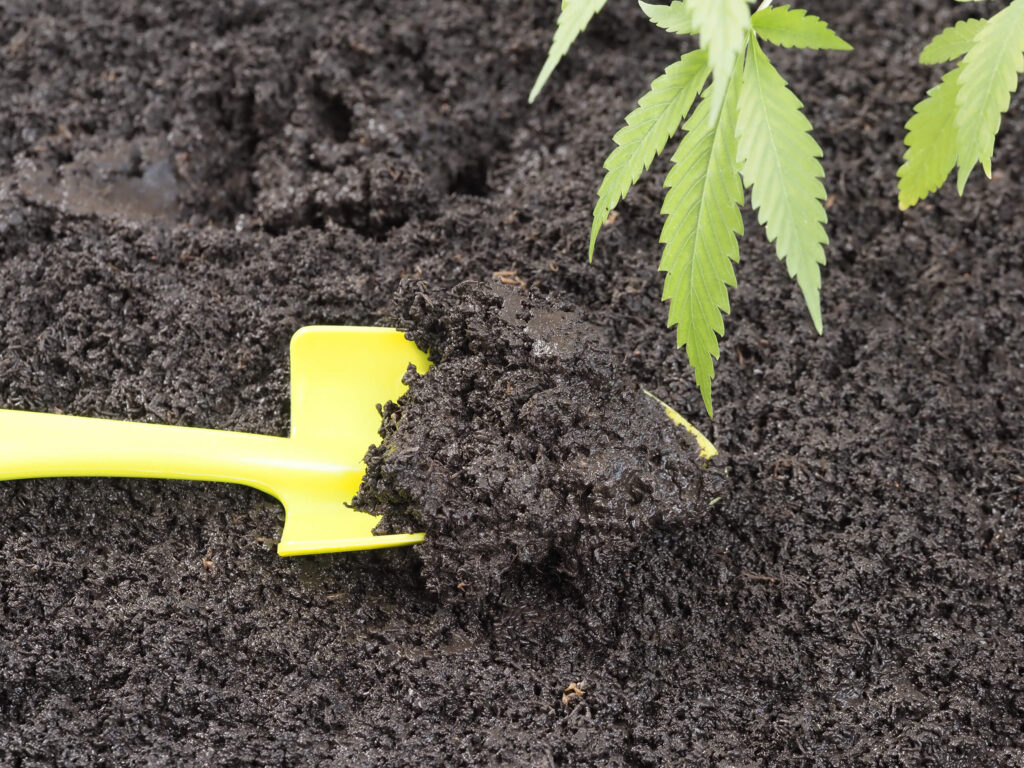
Using store-bought soil is super convenient. Simply buy your preferred soil mix online or from a physical store, fill up your pots, and you’ll be ready to go. Depending on the nutrient density of the soil you buy, you generally won’t need to feed your plants for the first 2-4 weeks of life, after which point you’ll want to begin using fertilisers.
Vegetative fertilisers, for example, are typically rich in nitrogen, while bloom fertilisers contain higher levels of potassium and phosphorus. In general, these fertilisers contain nutrients in forms that are readily accessible to plants, meaning they are absorbed almost instantly upon soil or foliar application. Combine that with a good starting medium, and it’s possible to grow very healthy plants that produce exceptional flower in express time.
Pros of store-bought soil for cannabis:
- Soil mixes are readily available online, at gardening centres, or at cannabis grow shops.
- The combination of a good potting soil and liquid fertiliser can promote very vigorous growth and the development of top-shelf buds.
Cons:
Note: Most of the cons of using store-bought soil mixes come from the use of liquid fertilisers, not from the soils themselves.
- When working with liquid fertilisers, growers need to keep tabs on their soil pH, Electrical Conductivity (EC), Exchangeable Sodium Percentage (ESP), and much more. Different fertilisers can also interact and interfere with one another, which adds an extra layer of complexity for beginners.
- Because they contain readily accessible nutrients, liquid fertilisers make it easy to over feed cannabis plants. Sometimes liquid fertilisers can also leave salt deposits in soil, which impede a plant’s ability to take up nutrients and water.
- Inorganic liquid fertilisers can produce runoff that’s toxic to the environment and tend to degrade soil over time, meaning growers need to buy new soil every season for consistent results.
- Cannabis plants grown with liquid fertilisers need to be flushed 1 week prior to harvest for a smooth, flavourful smoke.
Store-bought cannabis soil is ideal for:
- Home growers who are comfortable using liquid fertilisers and who enjoy the vigorous growth they promote.
How to fertilise cannabis plants growing in store-bought soils:
- Top-dressing with organic matter. Worm castings, humus, and compost all offer plenty of nitrogen during the vegetative phase, while bat guano and bone meal can be used to provide extra potassium and phosphorus during your plant’s bloom phase. Note that these components need to be broken down by soil bacteria before they can be absorbed by plants.
- Compost teas can be used as liquid fertiliser or foliar spray.
- Liquid fertiliser kits from brands like Fox Farms, Plagron, and Advanced Nutrients contain both vegetative and flowering fertilisers. These products are very popular among both indoor and outdoor growers and can produce excellent results.
Benefits of growing weed in nutrient-dense super soil/living soil
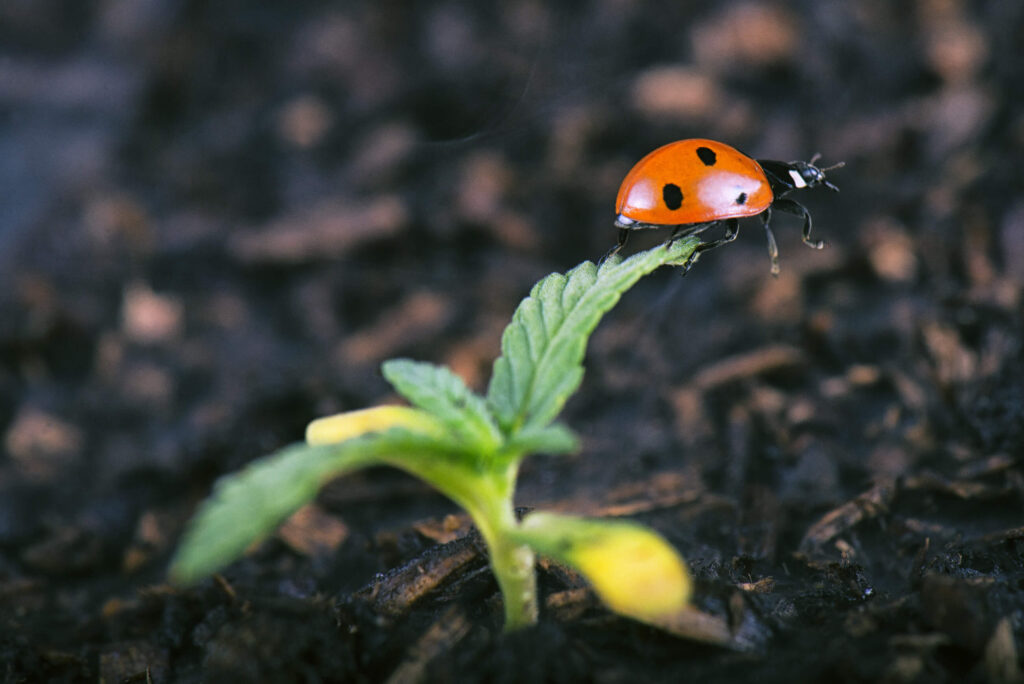
Growing cannabis plants in nutrient-dense soil is more akin to how plants would grow out in nature. Rather than relying on a human to provide them with liquid fertiliser, plants rely on microorganisms such as bacteria and fungi to break down organic matter and take up macro and micronutrients as they become available. Hence, they feed more slowly yet consistently. A properly prepared super soil, for example, can keep plants fed from germination right up to harvest.
Pros of growing cannabis in living soil:
- Nutrient-dense soils can keep your plants fed for long periods of time (sometimes even through their entire life cycle). Overfeeding cannabis is also virtually impossible when using these soils, as the nutrients they contain aren’t readily accessible to plants.
- When using nutrient-dense super soils, there’s no need to measure soil EC or ESP. It is still a good idea to regularly measure the pH of your water and soil, though.
- Growing cannabis in nutrient-rich soil minimises toxic runoff from your garden. Moreover, you can recycle cannabis super soils over several growing seasons, making for a much more sustainable operation.
- When using organic living soils, there’s no need to flush your plants prior to harvest.
Cons:
- Growing cannabis in rich super soils means giving up a certain degree of control. While you won’t need to measure as many parameters as when growing weed using liquid fertilisers, you also won’t have many options to help speed up or otherwise alter your plants’ nutrient uptake.
- Preparing living or super soil takes time.
- Plants grown in super soils typically grow a little slower than plants grown in store-bought soil and fed with liquid fertilisers.
Cannabis living soil is ideal for:
- Home growers that are interested in taking a more natural or organic approach to cannabis cultivation.
How to prepare the best potting soil for cannabis
Rather than buying ready-made soil mix, you can create your own soil for cannabis at home using ingredients readily available at most garden centres. Below you’ll find two recipes for cannabis potting soil, plus tips for creating the best soil for autoflowers:
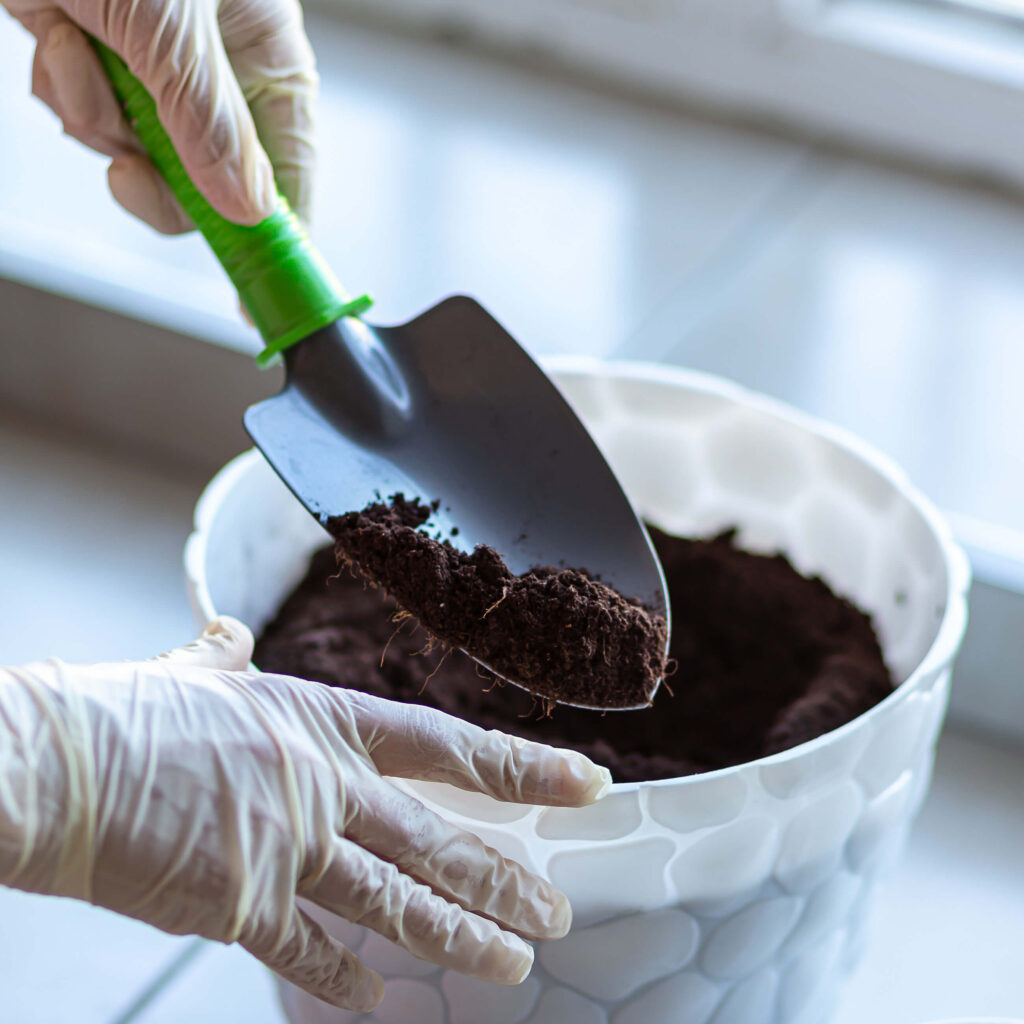
How to make a light cannabis potting soil (ideal for using in combination with liquid fertilisers)
Combine:
- 4 parts organic potting soil. This can be virtually any brand, but look for soil with good drainage and water retention. This will serve as the base of your cannabis potting mix.
- 1 part peat moss or coco coir.
- 1 part perlite and vermiculite.
- 1 part worm castings, humus, or compost.
- Optional: Add diatomaceous earth, mycorrhizal fungi, and rooting bacteria as per the manufacturer’s/retailer’s instructions. These products will help promote a healthy soil ecosystem.
Your soil should be dark in colour and have a light texture and structure. When watered, it should also retain some moisture while draining well. While it contains some light nutrients (ideal for seedlings and young plants), you’ll need to start feeding your cannabis plants by the third or fourth week of their veg cycle.
How to make a “hot” cannabis super soil (no need for extra feeding)
Combine:
- 4 parts organic potting soil.
- 1 part peat moss or coco coir.
- 1 part perlite and vermiculite.
- 1 part worm castings.*
- 1 part compost.*
- Blood meal (50g per every 1 kg of soil).*
- Bone meal (50g per every 1 kg of soil).**
- Bat guano (50g per every 1 kg of soil).**
- Diatomaceous earth, mycorrhizal fungi, and rooting bacteria as per the manufacturer’s/retailer’s instructions.
*- These nutrients are rich in nitrogen and will support your plants during their vegetative growth phase.
** – These are nutrients rich in phosphorus and potassium, which your plants will need during flowering.
The resulting soil should also look dark and have a light, well-aerated structure. You can plant seedlings or young plants directly in this soil, though some growers opt to let their living soil compost for 15-60 days.
To compost your super soil, keep it moist and in a closed container away from direct sunlight. Over time, the soil will get hot – a sign that the bacteria and fungi it contains are hard at work breaking down nutrients and making them available to your plants.
The best soil for autoflowers
Autoflowering cannabis plants are a treat for growers who do not want to manage different lighting schedules. Their reduced height also makes them very appealing to indoor growers working in small spaces.
Unfortunately, however, autoflowers can be sensitive to nutrients, and it’s not uncommon to hear even experienced growers run into nutrient issues when growing autos for the first time. However, you can avoid these issues by growing your autos in a soil made up of:
- 4 parts organic potting soil.
- 1 part peat moss or coco coir.
- 1 part perlite and vermiculite.
- ½ part worm castings.
- ½ part compost.
- 50g bat guano (per kg of soil).
- Diatomaceous earth, mycorrhizal fungi, and rooting bacteria as per the manufacturer’s/retailer’s instructions.
This soil marks a halfway point between the light and hot soils outlined above. Again, it should have a dark colour and light texture and will contain enough nutrients to keep your autoflowering plants fed from seed through to harvest.
Can you fertilise cannabis plants growing in rich organic soil?
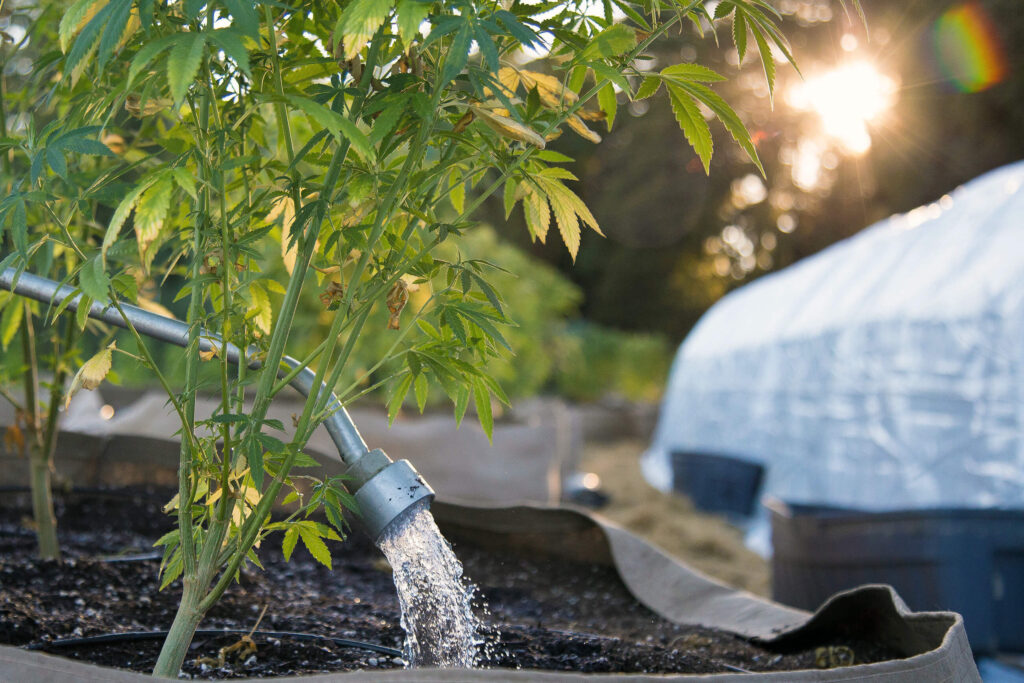
Yes, you can fertilise cannabis plants growing in super soil blends like those mentioned above. To do so, it’s best to use organic liquid nutrients, compost teas, or top-dressing with worm castings, compost, or bat guano.
Also, remember to only feed your plants when they need it. Take your time to learn about the signs and symptoms of cannabis nutrient deficiencies, and check out our article on mineral nutrition for cannabis for more information on how to fertilise your weed plants.
How to choose between buying soil from a store or making your own:
Whether you choose to grow cannabis in store-bought soil or your own soil mix largely depends on your personal preference. Either approach can produce excellent results.
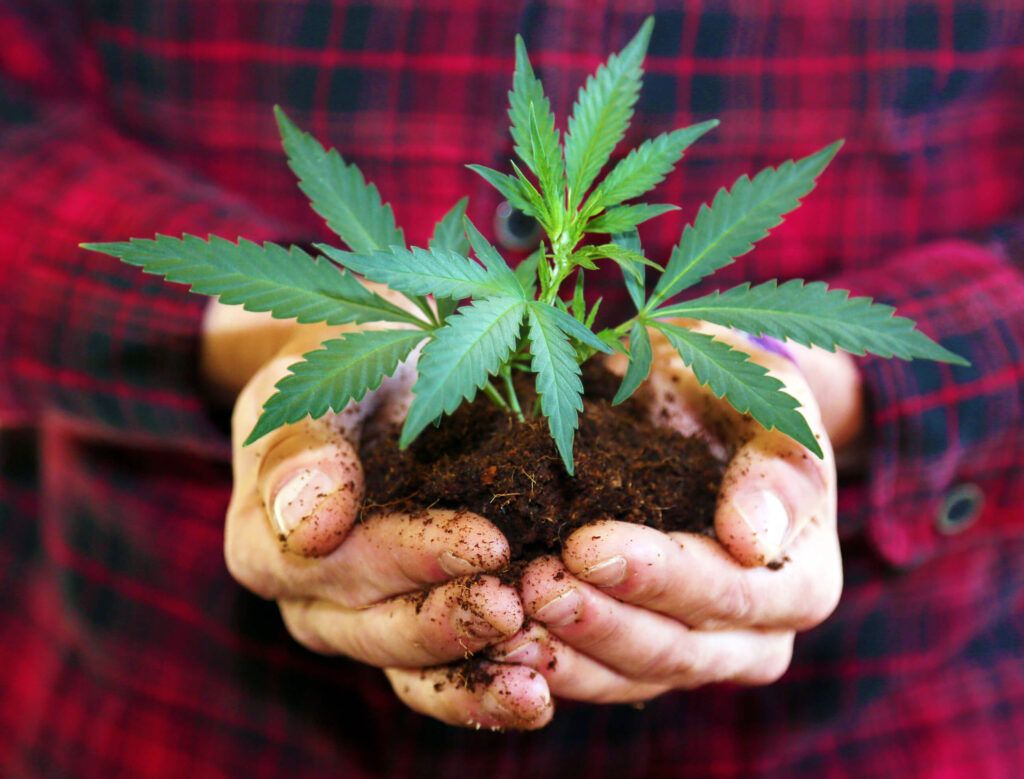
To help you decide between one or the other, ask yourself the following questions:
- Do you feel comfortable using liquid fertilisers?
- How interested are you in organic cultivation?
- Do you have the time to prepare your own soil mix?
Final tips on how to choose the best soil for cannabis
- When buying soil from a store, ensure it’s well-draining, aerated, and contains some kind of base nutrients for your plants. Humus, coco, peat moss, perlite, vermiculite, and compost are all quality ingredients to look out for.
- Avoid all-purpose potting mixes or soils made specially for ornamentals or vegetables.
- Always test the pH of your soil, regardless of whether you bought it from a store or prepared it yourself.
- While store-bought soils usually contain some base nutrients, you will likely need to fertilise your cannabis plants after a few weeks. Do this by top-dressing with organic matter, using compost teas, or using liquid fertilisers.
- When using liquid fertilisers on soil-grown plants, remember to flush 1 week prior to harvest for a smooth, flavourful smoke. When growing cannabis in super soil or living soil, flushing isn’t necessary.
- Preparing your own cannabis potting soil is simple and allows you to regulate how much nutrients your plants get directly from their medium. Store-bought soils, however, offer unbeatable convenience.
- Remember that soils and the organic matter they contain can house pest larvae and fungal spores. To grow your plants in sterile conditions, look into hydroponics.
So much for dirt talk! Here, we’ve explored the complex role of soil and how it directly affects the health of your plants and their harvest.
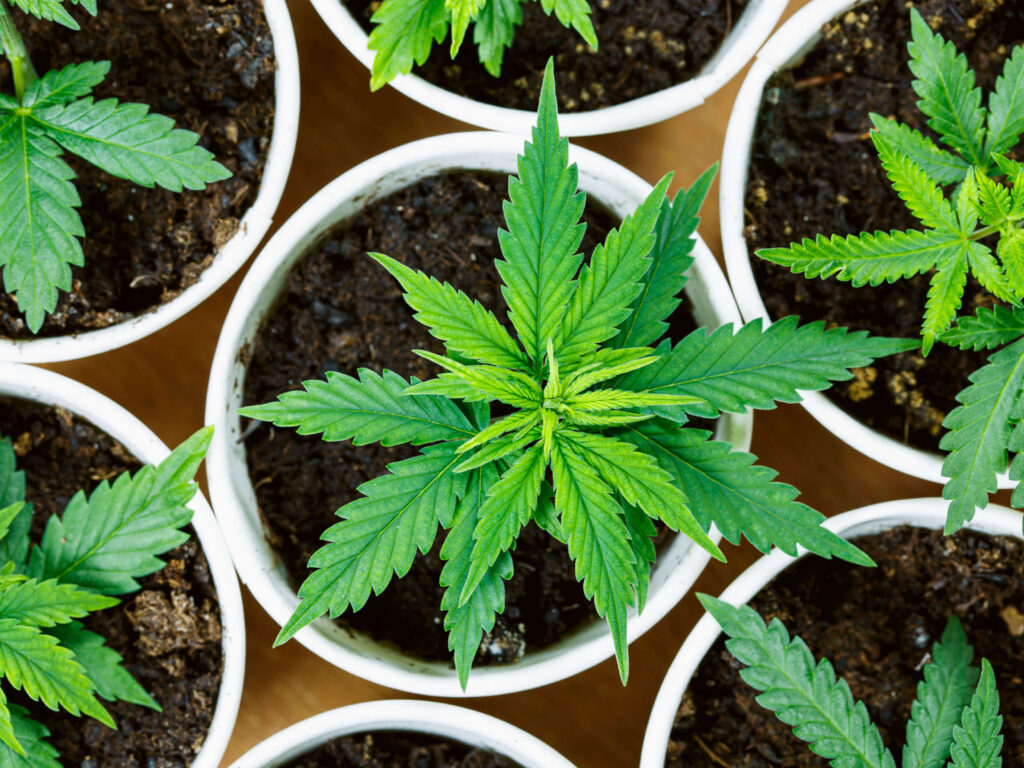
As an indoor cannabis grower, you can opt to grow your plants in store-bought soil and use liquid fertilisers to provide them with the nutrients they need. This is by far one of the most popular approaches to growing cannabis at home because it’s convenient and allows growers to fuel the growth of their plants extremely quickly.
Alternatively, you can also make your own soil mix for cannabis. Depending on how nutrient-dense you make the soil, you may never need to fertilise your plants during their entire lifecycle. Choosing between the two approaches will largely depend on your preferences, time, and skill.
Remember that there is no right or wrong approach to choosing soil for your cannabis plants, as long as the soil you choose contains some nutrients, is aerated, and well-draining. What’s your favourite approach to growing weed? Do you use store-bought soils, or are you a fan of living soil? Share your thoughts with us in the comments below and go get your hands dirty!
- Disclaimer:Laws and regulations regarding cannabis cultivation differ from country to country. Sensi Seeds therefore strongly advises you to check your local laws and regulations. Do not act in conflict with the law.






